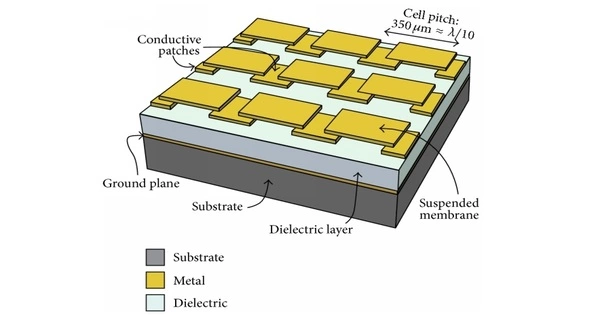A tunable metamaterial has properties that can be changed by an external stimulus such as an electric or magnetic field, temperature, or strain. Metamaterials are engineered materials with unique properties that allow them to manipulate electromagnetic waves, acoustic waves, and other types of waves in ways that conventional materials cannot.
A tunable metamaterial is one that responds differently to an incident electromagnetic wave. This includes remotely controlling the interaction of an incident electromagnetic wave (EM wave) with a metamaterial. This translates to being able to determine whether an electromagnetic wave is transmitted, reflected, or absorbed.
Tunable metamaterials are particularly appealing because they provide a high degree of flexibility and control over the material’s properties, which can be adjusted on demand. For example, by applying an electric field to a tunable metamaterial, the refractive index of the material can be changed, which can then be used to manipulate light propagation. Tunable metamaterials are appealing for a variety of applications, including communications, sensing, and imaging, due to this property.
In general, the tunable metamaterial’s lattice structure is adjustable in real time, allowing a metamaterial device to be reconfigured while in use. It includes advancements in left-handed materials that go beyond bandwidth limitations by constructing various types of metamaterials. In this domain, ongoing research includes electromagnetic materials that are very meta, which means good and have a band gap metamaterials (EBG), also known as photonic band gap (PBG), and negative refractive index material (NIM).
Tunable metamaterials can be created in a variety of ways. One approach is to use materials whose properties change in response to an external stimulus. For example, some materials exhibit a change in their refractive index when subjected to an electric field, while others change their acoustic properties when subjected to a magnetic field. Another strategy is to employ metamaterial structures that are programmed to respond to an external stimulus. Some metamaterials, for example, are designed to change their resonant frequency in response to a magnetic field or temperature change. This property can be used to create tunable filters and other adjustable devices.
There are several ways to create tunable metamaterials. One approach involves using materials that exhibit strong nonlinear responses to external stimuli, such as ferroelectric or ferromagnetic materials. Another approach involves designing metamaterials with tunable resonant frequencies, which can be achieved by varying the geometry of the microstructure or by incorporating materials with different dielectric properties.
Tunable metamaterials are a hot topic in science, with researchers looking for new ways to create materials with even more sophisticated properties. Tunable metamaterials are likely to find more applications in a variety of fields as the field advances. Overall, the ability to tune the properties of metamaterials makes them a highly promising technology for a wide range of applications, and ongoing research in this area is likely to yield even more exciting discoveries in the future.
















